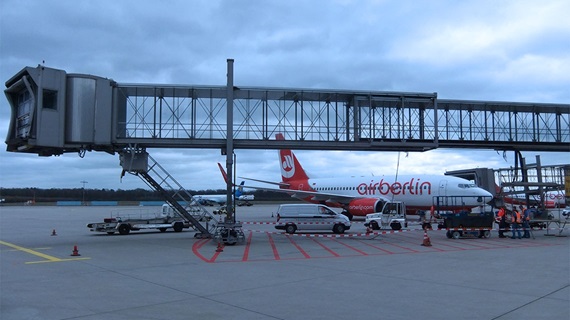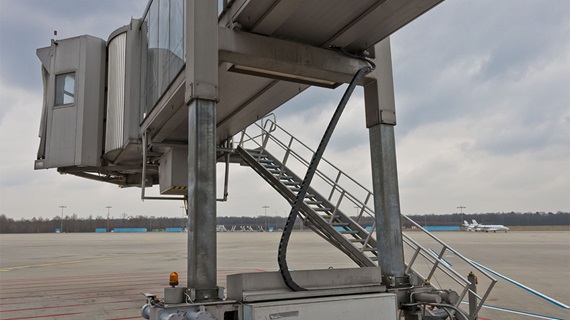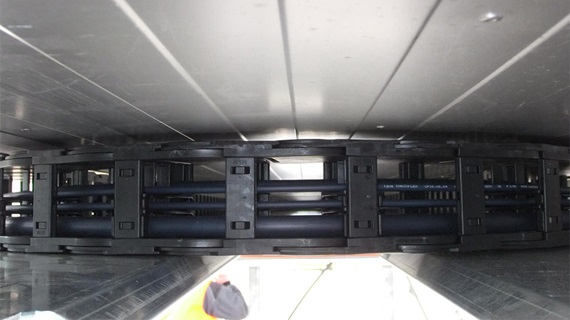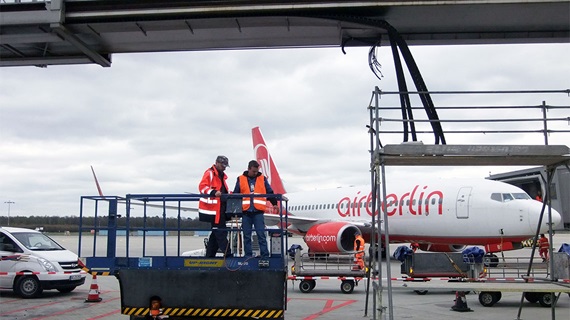Airline passengers get on board with energy chain solutions
Eight jet bridges at Cologne Bonn Airport have been equipped with energy chains and cables from igus
Jet bridges are designed to allow passengers to safely and quickly get from the airport building onto the aeroplane and they supply the plane with power while it is parked on the ground. To ensure that the cables that supply the jet bridge control system as well as the aeroplane are routed safely for the future, eight bridges were retrofitted in succession in co-operation with the material handling department of Cologne Bonn Airport and modernised to last the next few decades. Aside from engineering this telescopic solution and the components for the new cable conduit system, the Cologne-based manufacturer also provided on-site installation at the airfield.
- What was needed: E4/4 chains, E2 zig-zag chain, chainflex TPE special cables, 400 Hz special cable
- Requirements: High security precautions delay installation, installation must flexibly conform to the travel volume
- Industry: Airport
- Success for the customer: Completely revised energy chain system with better access, flexible and on-time installation

Problem
Each year approximately ten million passengers walk across the total of 18 jet bridges at all of the terminals at Cologne Bonn Airport. The bridges ensure that the path from the terminal to the aeroplane is as easy as possible for the passengers. After the engines have been switched off, the bridge also handles powering the on-board avionics of the parked aeroplane. The bridge docks to the plane as soon as it has reached its parking position. The bridge consists of a fixed and a moving or telescopic section. The height of the movable bridgehead can also be adjusted to precisely reach the aeroplane door. All movements are hydraulic. The control system and signal routing happens via electrical cables. In order to guide these safely and securely across all movements and to ensure the functionality of the bridges for the next few years at Cologne/Bonn Airport, the complete energy supply system of the eight bridges of the new Terminal 2 had to be modernised. Special challenges exist in such a case, especially in the assembly of the energy supply system. As the airport is a high-security site, the installation of a system has to be planned well in advance in order to be ready on time later on. After all, the elaborate security precautions at airports can already significantly slow down the work and logistics processes. The assembly planning must also be adapted as flexibly as possible to the airport's travel volume, as none of the bridges must be missing during the peak holiday season in the summer months, for example.Solution
When the passenger boarding bridges were first equipped in 1999, energy chains from igus were already used at that time, which have also run trouble-free to date. The arrangement of four chains per system at the time (due to the very limited installation orientations in the bridge housing), nonetheless, left room for improvement. The energy supply hidden under the outer skin of the bridge had also not been accessible for possible malfunctions or visual inspections.The task for the project engineers was, therefore, to optimise the selection and arrangement of the e-chains and accessibility for maintenance purposes. In the process, the energy chains, cable assignment and also the steel substructure of the bridge were optimised. After consulting with igus, the customer decided to also commission on-site assembly.
The new cable conduit system of the retrofitted bridge now consists of two opposing (facing each other) E4/4 chains that have been turned through 90° which now have a sufficient capacity to separate and guide the cables. Additionally, an E2 zigzag chain is used at the bridgehead for vertical adjustments. All energy chains are equipped with wind and weather-resistant chainflex TPE special cables for energy chains as well as with a 400 Hz special cable for the on-board power supply of the aeroplane, which is now well-protected.
The jet bridges now have an expected service life of 25 to 30 years.
Detlev Stäbler, Head of the Conveyor Technology Department at Cologne/Bonn Airport


Installation service with maximum flexibility
After the airport decided to have the bridges modernised by igus, the special challenge lay in the installation planning of the system. This had to be done with as much flexibility as possible in accordance with the travel activity at the airport, since it would not be possible to extend any of the bridges during the main travel season in the summer months. "igus and its Installation Service once again proved to be incredibly flexible partners," says Stäbler, "We are very grateful for that. " This meant one bridge after the other was taken out of service for a short time and retrofitted during a time window of about two weeks each with the flexibility to adapt to travel activities. It took about 1.5 years before all the bridges had been retrofitted. Common agreements and co-ordination between the Material Handling department at the Cologne Bonn Airport and igus worked out extremely well for the entire duration and the collaborative efforts of everyone involved ended in a resounding success.